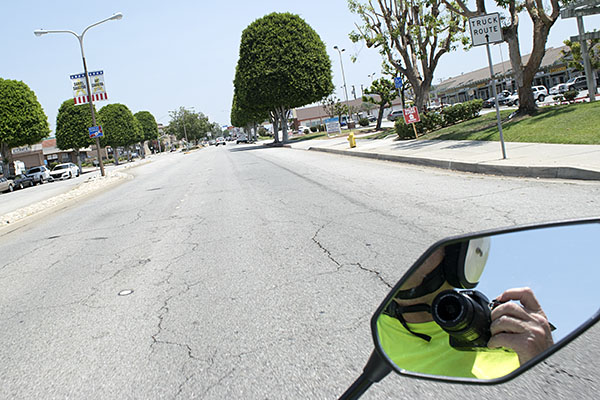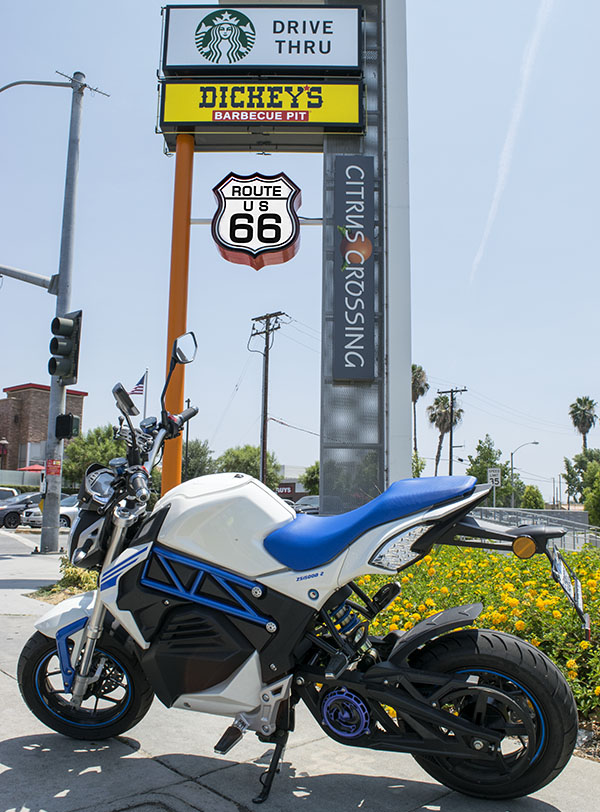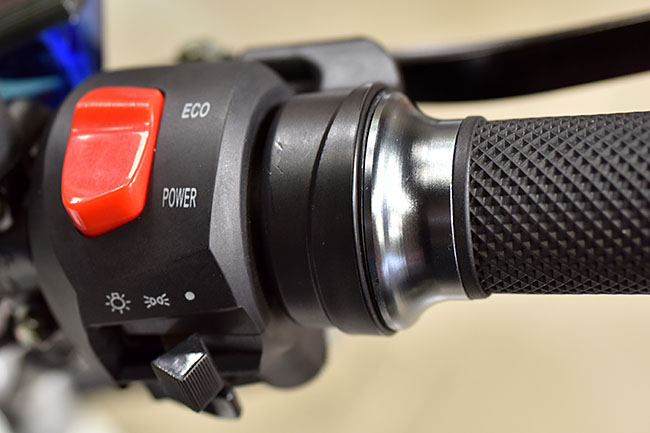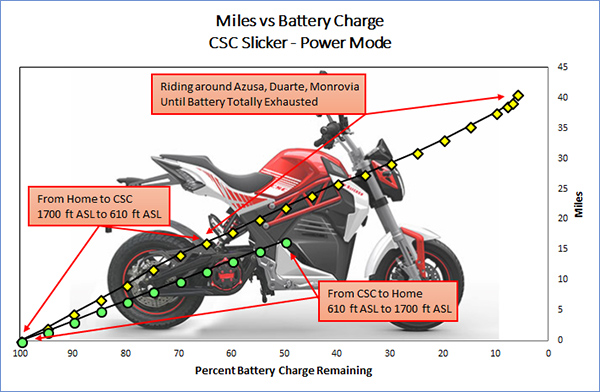
This is Phase II of our CSC City Slicker range testing. Phase I examined how the bike performed in the Eco mode. In this phase, today I tested the bike’s range in the Power mode.
Bottom line first: The bike went further then Zongshen said it would. Zongshen claimed the bike would go 37 miles at 37 mph. I managed to go 40.7 miles when starting with a 100%-charged battery. I attribute that to the fact that part of the course I ran today had a gradual downhill slope.

There’s a lot more to this test than what I did in the Eco mode testing. I should start out by telling you that this was not a test run on a perfectly flat, uninterrupted test track (I’m pretty sure if I did that I would have managed to get even a few more miles out of Slick). Nope, this was real world testing on American roads. In fact, I’d say it was real world testing on what is arguably the most famous road in America: Route 66. (Cue in the theme music from the ‘60s TV show, Route 66). It was that cool. Call me Todd. Arjiu can be Buzz. All we’d need is the Corvette. But I digress…back to the main attraction.

So, I live a little over 16 miles east of CSC at the base of the San Gabriel Mountains. My home is at 1700 feet above sea level. CSC, from my home, is headed toward the ocean, and that means a gentle downhill slope all the way. CSC sits about 610 feet above sea level. You might wonder why all the topological details, and here’s the reason: I found during my Eco mode testing that Slick uses less energy going downhill than it does going uphill. The bike covered about a mile for each 1% of battery charge going downhill, and about 0.4 miles for each 1% of battery charge going uphill. One of the things I wanted to find out in today’s Power mode testing is how the bike would perform from an energy consumption perspective in the Power mode, going downhill and then uphill.
I guess I ought to point out that I had a difficult time staying at 37 mph during this test, which is the speed for which Zongshen provided the range statistic. Every time I wasn’t really paying attention, I found myself going 42 or 43 mph (and those higher speeds use more energy). It was a challenge watching the road, watching the battery charge indicator, watching the mileage, and recording the data on my high-tech data logging system.

The bottom line here is I probably penalized the bike a little because I spent more time than I thought I would above 37 mph.
Oh, and in case you’re wondering what’s magical about 37 mph, I’m only hanging on that number because that’s the data point Zongshen gave us for range and speed in the Power mode: 37 miles at 37 mph. And in case you’re wondering why Zongshen picked the number 37, they really weren’t being cute about it. Zongshen’s real magic number was 60. 37 miles at 37 mph is 60 km at 60 kph. They’re on the metric system.
To cut the chase, here are the results…

I know that’s a complicated chart, but hey, I’m an engineer, and there’s a lot going on here. Let me explain it a bit.
I only recorded the data with each 5% decrease in battery charge for this test. I was moving a lot faster than I was in the Eco mode test, and I didn’t want to try to capture data points with every 1% decrease in battery charge.
The top line (the one with the yellow data points) was my ride out to CSC and beyond. It was downhill for the first 16.4 miles (from my home to the CSC plant). Starting with a 100% battery charge, my ride to the CSC plant took me down to 65% charge remaining. Stated differently, I used 35% of the battery charge to get from my place to CSC. I was impressed. If I was still a working stiff this would be a cool commuter bike.
I wanted to run the battery all the way down until the bike quit, and that meant I kept riding back and forth between Azusa, through Duarte, and into Monrovia. Those are the yellow data points on the upper line after reaching the CSC plant. I kept doing that until the battery hit 30% charge remaining (at which point the red plug to the left of the charge indicator started flashing, just as it had in the Eco mode test).

When I got down to 15%, the bike went into its “limp home” mode again, just as it had in the Eco mode. When this happens, it accelerates much more gradually (that’s a gentle way of saying Slick is getting tired), and the bike tops out at about 20 mph.
I kept going in the CSC parking lot, riding in circles until the bike hit 6% charge remaining. I rode for another 0.4 miles at 6% charge when Slick called it a day. I watched to see if it would indicate 5% just before giving up the ghost, but I didn’t see that on the dash. I think when the bike drops from 6% to 5%, you don’t get to see it indicate 5%, but that’s where it quits.
To my surprise, I blew right through Zongshen’s claimed 37 mile range. I made it to 40.7 miles. And, as I mentioned in the Eco mode test, the odometer is about 5% pessimistic, so the indicated 40.7 miles is actually 42.7 miles. This is good, folks. Again, though, the fact that I went more than 37 miles is at least partly due to the fact that this leg of the test was slightly downhill.
I mentioned in the specs that the bike has regenerative braking. When that occurs, the red plug to the left of the battery charge bar illuminates. I never actually got it to cause the indicated charge percentage to increase, though. If it was at, say, 67% and it went into a regenerative braking mode, there wasn’t enough regeneration going on to bump it back up to 68%. The bike is obviously consuming less energy and it is charging, but not enough to register on the numerical percentage indicator. You do see the charge bar go up sharply (it swings to the right) while the red charging plug flickers on during deceleration. It’s cool. You feel like you’re giving something back.
The other thing I could not discern is how the algorithm operates the regeneration function. It seemed to me that the regeneration light came on while I was decelerating as my speeds dropped below about 10 mph and I was braking. I don’t know if that’s because there’s a lag between when the regeneration actually starts and when it is displayed on the dash, or if Zongshen has programmed something into the bike to prevent too much regeneration. I’m emailing them to find out, and I’ll let you know.
My big disappointment today? There was only one: When I got to CSC, all the burritos were gone. Saturday is burrito day at CSC. But I’m still young, and I’ve been working on handling disappointment.
Steve had a freshly charged battery waiting for me, and I wanted to do a video of the battery removal. One of the guys following the ExhaustNotes blog asked for that, so here you go…
Guys, when you see the video, be gentle. I’m not Cecil B. DeMille. I know that. You need to know that I know that. If you want to be a video critic, start a blog or something.
With a new battery in place, it was time for my ride home. I was very curious to see how this would go, because now instead of descending from 1700 feet to 610 feet, I’d be climbing that same 16.4-mile grade. I’ll post the graph here again so it’s easier to put the words and the music together…

The bottom data line (the one with the green data points) shows energy consumption as a function of miles on the uphill ride home. You can see that the bike uses more energy going uphill than it does going downhill (again, duh, but the data shown in the above graph makes it clear). Some folks are confused by x-y plots (hell, some folks are confused by, well…never mind). Don’t look at this graph and think that the shorter lower line with the green dots means the bike will only go 16.4 miles. I still had 50% of the battery charge left at that point. I was home. I parked the bike, went inside, and opened a can of Tecate (which I’m nursing as I write this blog).
So, here’s the take-away from today’s testing:
- The bike goes further in the Power mode than Zongshen said it would. This is good, but temper my results with the course I rode (part of it was slightly downhill).
- I used 35% of the battery’s energy going from my home to CSC (a gradual descent) and I used 50% of the battery’s energy going from CSC to my home (a gradual climb).
- This motorcycle is a lot of fun and it gets a ton of attention. Every time somebody stopped alongside me at a light, the questions and compliments started. I don’t mind admitting I enjoyed that.
- I think these guys (that is, CSC) aren’t charging enough for the bike, but hey, what do I know?
And there you have it. Slick’s on the charger now. I’m going to the rifle range tomorrow to send some lead downrange. On Monday or maybe a little later in the week, me and Slick are going to do some climbing up in the San Gabriels to see how the steeper grades affect range. As always, if you have questions, post them in the Comments section, and I’ll do my best to get answers for you.

I adore my RX3.
That being said…
I’m still curious about a larger diameter wheel swap on this electric bike. Extending the rear swing arm and raising the front fender to accommodate something like a Ninja’s 15″ wheels.
Knowing full well that that would void any warranties and affect riding geometry.
As a designer with some limited fabrication skills, I would love to get my hands on a test mule after someone else has beaten the poor thing to an inch of its life.
Joe, great write ups on Slick. Do you need a motorcycle endorsment to ride these on the street or are they like a moped that anyone can ride legally w/o an endorsement?
Thanks, Rob. I’m not sure about the other states, so you’d have to check. In California you need a motorcycle license. In China, you do not.
Hey, we need to get together and ride Baja again, Amigo!
Hi Joe. I notice in the video that the motorcycle you’re testing has a blue seat, white “gas tank” and a generally different colorway than the image posted on the CSC website. You mention that there are 3 bikes in the CSC shop. Do those bikes match the bike you’re testing or do they look more like the images on the CSC website? I personally prefer the colorway of the bike on the website and hope thats the final look.
Finally, do you know if CSC is planning or recommending any changes or modifications with the manufacturer based on your testing? If so, are you at liberty to share?
Please don’t raise the price of the bike. Please wait until after i’ve completed by purchase. 🙂
CSC received 3 bikes total. All three are the same color. I’m using one for testing. The production bikes will be the colors shown on the CSC site (blue or red).
I haven’t found any changes I’d recommend to the configuration I’m testing, other than the one I know about (having LED running lights).
I’m not the guy who makes decisions about pricing. My comment about pricing was just a thought. I don’t think CSC has plans to raise the pricing beyond the $2495, but again, that’s not my call.
Will CSC sell the battery separately? I’d be interested in having a second one around to hot-swap on a long trip, or whatever.
I believe CSC plans to do that, but you’d have to check with CSC. Their number is 909 445 0900/
Question on operation.
From the pictures I notice that there are levers on both bars. What’s each lever used for since there is no clutch on the left? Are both levers brakes? Right – front brake, left – rear brake or vice versa like bicycle standards ?
The right lever is for the front brake, and the left lever is for the rear brake. It’s identical to the controls on a motor scooter.
Thanks for the test and results. Looks like the range is pretty decent for a commuter bike.
I’m looking forward to your report in the mountains. My commute is about 4 times as steep as your test hill. Wanting to know what speed the bike will maintain going up a real hill. Better yet, bring a passenger & find a steep hill.
Thanks!
No plans to run the test with a passenger. I’ll take the run up into the San Gabriels later this week. Power consumption will be higher going up steeper hills. Stay tuned, more coming…
What would the top speed be on fairly level stretches of road ? I’m interested, but there are some short stretches of my commute that I need to go at least 45mph, of course I realize this would reduce the range a bit, but I don’t want to be relegated to the shoulder.
Thanks
The published top speed is 46.6 mph, and the speedometer shows an indicated 46-47 mph flat out (but the speedo is roughly 10% optimistic). On my GPS, the bike topped out at about 42-43 mph.
Is the battery compartment sealed in any way from dust and water? When watching the battery change video i didn’t notice any weather stripping on the battery door. With that in mind, is the battery air cooled through vents at the front or on the side of the bike?
The battery compartment is not sealed. There are several vents. I’ve been riding in temps well over 100 degrees; overheating has not been an issue.
Thanks again for all your blog entries and testing – much appreciated!
I’ve made my purchase and I think it’s going to work well for me – but – you noted it went into limp-home mode at 15% remaining. That means for those of us on public streets with cars expecting to go 35+, we’ve now become a hazard.
Yes, we can “get home” or get to ‘safety’ rather than being stuck on the side of the road, but we are kinda in a bad spot. But what is the mileage you were at when you jumped to limp mode? To me, that’s where I need to be back “home.” It appears to be around 35 miles?
To me this would be the true range in Power mode. You can go 30-35 miles at 40 MPH, then you better be off the roads. My commute, is 24 miles RT, so 35 miles would be great, can even make quick side trip to grab something on the way home or go to lunch.
In future reporting, can you pls note that “full power” range. I’d hate to be 3 miles remaining on my commute with a 20 MPH top speed. I’d die here in NJ!
I grew up in NJ and I’m back there on a regular basis, so I know what you’re talking about. I’ve described the results I attained, and you see what the mileage is on the charts I’ve posted at various battery percentages. I should also point out that these are one set of results on the roads I rode, and for a guy my size. Different rider weights, inclines, headwinds, tailwinds, tire pressures, temperatures, etc., will all factor into what your bike will do. I’d plan on plugging the bike in at work, and at home, to keep it “topped off,” just to be sure.